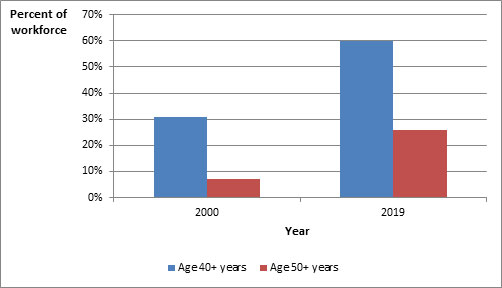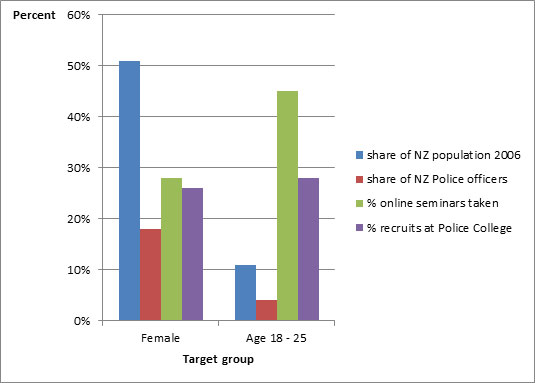Get The Balance Right
It is important that such a large workforce reflects the makeup of the population it serves.
The New Zealand Police’s mission is to be a world-class police service, working in partnership with communities to prevent crime and road trauma, enhance public safety, and maintain public order. In 2012, the Police’s budget was about $1.5 billion. There are 12 policing districts covering the country, with more than 400 police stations and about 12,000 full-time equivalent employees. It is important that such a large workforce, interacting daily with the public, reflects the makeup of the population it serves.
Demographically, the Police’s workforce has not kept pace with the changes in our population. To compound this, its workforce profile is ageing at a faster rate than the total population.
What did the Police do to get a more balanced workforce?
The Police wanted to recruit a more balanced workforce. In August 2008, the Police committed to recruiting an additional 600 officers by December 2011. Ideally, these recruits needed to include younger people (aged 18 to 25), women, and people from the Māori, Pasifika, and Asian communities. The graph below shows what would have happened to the Police’s age profile by 2019 if no action was taken.
Age profile of Police officers, from 2000 to 2019

Source: New Zealand Police.
Note: Figures are rounded and 2019 figures are based on a projection of the recruitment and attrition trend from 2000-2009.
The Police faced three big challenges in achieving the recruitment target:
- there was to be no change in the quality of candidates that it would accept;
- it faced a fiercely competitive employment market; and
- the 2011 recruitment budget had fallen by 61% since 2008.
The decision to use social media to help recruitment
Senior managers in the Police were, and still are, supportive of the use of social media. But they recognised that social media posed some risks, so there are guidelines and other measures in place to help mitigate them.
The Police approach to using social media was to create a dialogue with potential recruits through social media. The Police used the campaign “Better work stories” to communicate the nature of the Police’s work to the public, as a varied, challenging, and exciting career.
Alongside traditional advertising, the Police decided to use social media to challenge the target groups’ perceptions and tackle other potential recruitment barriers.
The Police formed a working group of people from different departments, including recruitment, communications, and public affairs. The working group operated closely with the Māori, Pacific and Ethnic Services Team, district recruitment officers around New Zealand, and front-line officers. The working group liaised closely with external communications partners.
The Police approach to using social media was to create a dialogue with potential recruits through social media.
The Police prepared a business case for using social media. The business case set objectives, did a risk assessment, allocated a budget, and set the key success factor of capturing a critical mass of followers.
The approach to using social media
The Police’s approach included:
- Facebook – this provided a public forum where people interested in a police career could interact with the recruitment team and other candidates. It also featured status updates using real work stories from officers, online seminars, and promotion of local recruitment events.
- Twitter – several officers around New Zealand regularly tweet their work stories and are known as the “Twitter cops”. Some of their stories were re-tweeted by the recruitment team and they also featured on the Police’s Facebook page for recruitment.
- YouTube and Flickr – these sites provided channels for relevant videos and photographs.
- Other media – Police stories were converted into street art installations in Wellington, Christchurch, and Auckland. This paid-for advertising was amplified in blogs and other social media as the target groups discussed the campaign, providing unpaid publicity.
Did it work?
The campaign’s objectives were ambitious. The Police wanted to recruit 600 new officers, increase the diversity of the workforce, reduce recruitment costs, and build engagement and a positive perception of a Police career among target groups.
Despite the ambitious nature of the campaign, the Police report that it has been successful. The target of 600 extra recruits has been met and the cost to attract each recruit was 29% lower than it was from 2008 to 2010.
The Police say that it has had successful engagement with target groups through its recruitment page on Facebook. As at April 2013, the recruitment page on Facebook remained the third most “liked” official page in the state service, with almost 17,000 “likes”. The Twitter account for the work stories, @BetterWorkStory, has about 4000 followers.
The two stages of the recruitment campaign were to get potential recruits to participate in an online seminar and then to recruit them into the Police. The graph below shows that:
- compared with the Police as a whole, a larger proportion of females took the online seminar and were then recruited into the Police; and
- compared with the New Zealand population, a higher proportion of young people took the online seminar and were recruited into the Police.
Results of social media recruitment among women and young people

Source: New Zealand Police.
Despite the ambitious nature of the campaign, the Police report that it has been successful.
The graph below shows that, compared with the Police as a whole:
- a higher proportion of Asian and Pasifika people took the online seminar; and
- a higher proportion of Asian people and a similar proportion of Māori were recruited.
Results of social media recruitment among Māori, Asian, and Pasifika people, 2011

Source: New Zealand Police.
The campaign was not quite as successful with Pasifika people. The Police attributed this to the lack of relevant “Better work stories” in 2011. In 2012, the Police gave this more attention, especially addressing fears that joining the Police involves a loss of cultural identity.
One method involved a street art installation about a Pasifika officer who uses his background and cultural values to help a woman who was seeing demons. Another method involved posting material online specifically for a Pasifika audience. This amended approach dramatically improved the response rates for Pasifika people in 2012 and 2013, with 7% of recruits at the Royal New Zealand Police College identifying themselves as Pasifika and a 29% increase in online seminar participation.
Another objective was to improve target audiences' perceptions of a Police career while tackling key barriers to recruitment. The Police report that social media commentators have been complimentary about the Police’s use of social media for recruitment. For example, @BetterWorkStory featured in a "top tweeters' top tweeters" list compiled by the New Zealand Herald. In that list:
- @CateOwen said that “Most tweets have me laughing out loud and wishing my work stories were as good" and also said "Companies that do a good job on twitter: ASB, BNZ, Telecom and the police… @BetterWorkStory do a brilliant job.”
- @TroyRF, the NZ Herald’s social media editor, tweeted "I'm a Big Fan. It's like a cross between Police 10-7 and Sideswipe. and then said [@BetterWorkStory] …is a great way of reminding people of the community aspect of policing."
Overall, social media has contributed to better recruitment outcomes and perceptions about the Police – and a better balance has been achieved.
What did the Police learn?
Be true to your audience.
The Police analysed its experience with using social media for recruitment and identified that workload can be reduced, early interaction with potential recruits can be positive, and the use of social media can amplify messages.
According to the Police, it is important to:
- Tailor your social media offering to your audience. Posts that resonate strongly with a target audience have a greater likelihood of generating the behaviour you want from them.
- Analyse your experience and make changes if it is not working as intended. For example, a generic brand and tone of voice is fine, but the content has to be something your target audience can relate to. To generate responses from different ethnic groups, talk specifically to your target group. This will provide a better response, but also increase engagement and response from others who feel compelled to enter the conversation.
- Think long-term about your content and make sure it is sustainable. As technology evolves, the programmes and platforms where people interact will change. But concentrating on the content means that you won’t have a shortage of it to fill whatever new technology comes along. Police used the idea of “Better work stories” to generate an endless stream of content.
- Harvest content from your staff – they could be dealing with stakeholders, service users, and the general public every day. They will have valuable thoughts, quips, stories, photos, videos, insights, and questions. If channelled correctly, it can make excellent social media content. Set up ways to harvest, moderate, and use the best content from your staff.
- Investing to build a strong base of followers in year one pays dividends in year two and beyond. Police recruitment needs will change over time to reflect staff attrition and operational requirements. In 2013/14, the Police expect higher recruitment than 2012/13. Having an engaged “pipeline” of social media followers provides the ability for a recruitment surge if necessary.
- Be true to your audience.
The Police defied conventional social media wisdom that warns against filtering negative commentary on Facebook, and instead prioritised the interests and welfare of the intended audience. When abusive or anti-police sentiment appeared on Facebook, advocates would initially come to the Police’s defence. But the advocates were seen to retreat when they became the victims of abusive commentary. This pattern was at odds with the purpose of inspiring and encouraging potential recruits. With that in mind, page moderators made a policy decision to be less tolerant of abusive posts and used their discretion to remove abusive or anti-police comments.
The Police believes that public entities need to be clear about the purpose of their Facebook page and moderate it to best serve that purpose. A Facebook page is not necessarily a mechanism for people to vent their frustration – that could be better dealt with through formal complaint channels. If anti-social behaviour occurs, the Police decided to determine whether it jeopardised the general health of its community and act accordingly.
A summary of the lessons the Police learned is shown below.
Lessons the New Zealand Police learned from using social media for recruitment
| Lessons |
|
